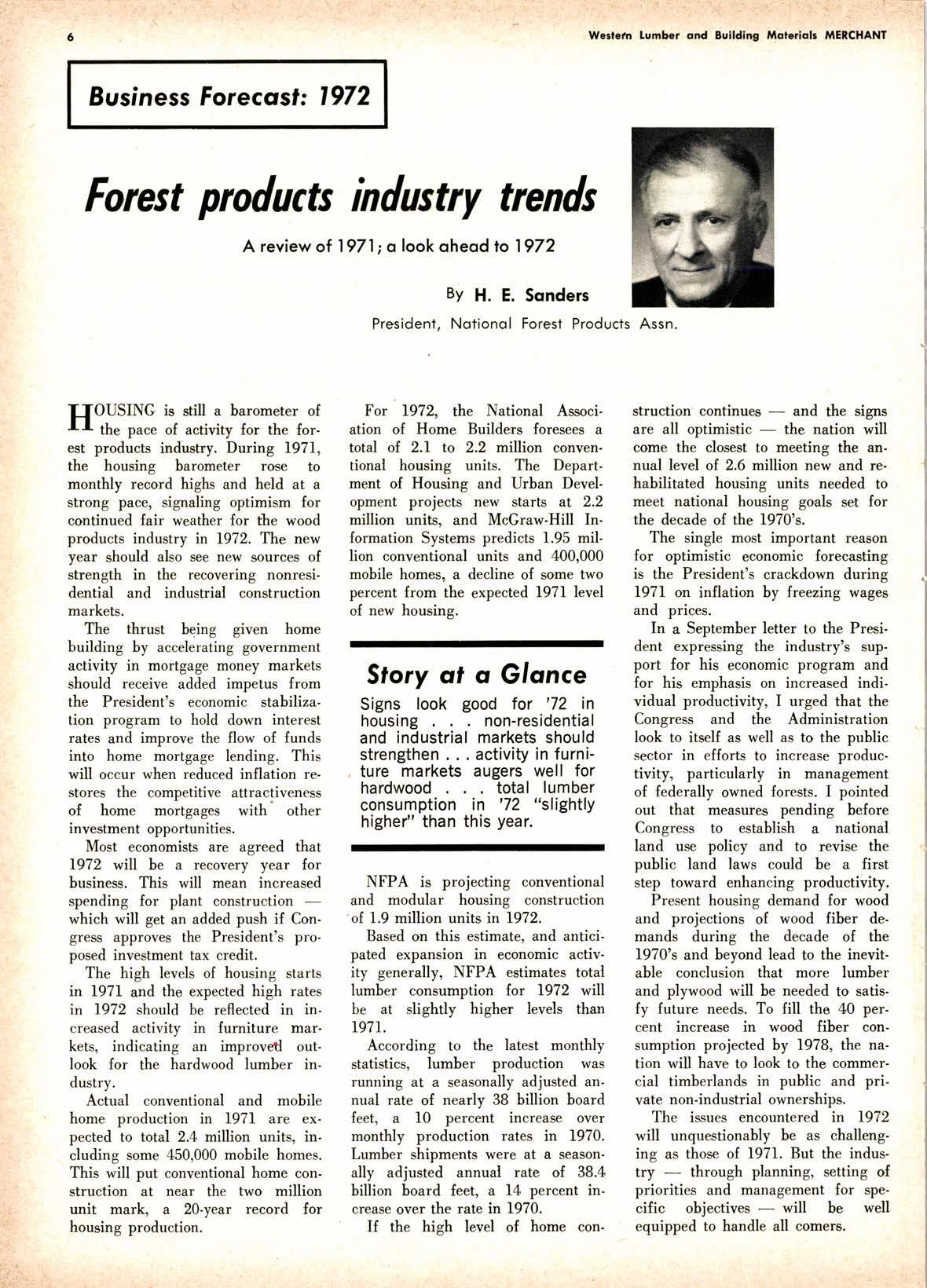
2 minute read
Forest products industry trends
A review of 1971; o look oheod to 1972
By H. E. Sonders President, Notionol Foresf Products
IJOUSING is still a barometer of rr the pace of activity for the forest products industry. During 1971, the housing barometer roae to monthly record highs and held at a strong pace, sigaaling optimism for continued fair weather for the wood products industry in L972. The new year should also see new sources of strength in the recovering nonresidential and industrial construction markets.
The thrust being given home building by accelerating government activity in mortgage money markets should receive added impetus from the President's economic stabilization program to hold down interest rates and improve the flow of funds into home mortgage lending. This will occur when reduced inflation restores the competitive attractive.ness of home mortgages with' other investment opportunities,
Most economists are agreed that 1972 will be a recovery year for business. This will mean increased spending for plant constructionwhich will get an added push if Congress approves the President's proposed investment tax credit.
The high levels of housing starts in I97I and the expected high rates in 7972 should be reflected in increased activity in furniture markets, indicating an improvd outlook for the hardwood lumber industry.
Actual conventional and mobile home production in l97I are expected to total 2.4 million unitso including some 450,000 mobile homes. This will put conventional home con. struction at near the two million unit mark, a 20-year record for housing production.
For 1972, the National Association of Home Builders foresees a total of 2.1 to 2.2 million conventional housing units. The Department of Housing and Urban Development projects new starts at 2.2 million units, and McGraw-Hill Information Systems predicts 1.95 million conventional units and 400,000 mobile homes, a decline of some two percent from the expected 1971 level of new housing.
Sfory dt d Glonce
Signs look good for '72 in housing non-residential and industrial markets should strengthen . activity in furniture markets augers well for hardwood total lumber consumption in '72 "slightly higher" than this year.
NFPA is projecting conventional and modular housing construction 'of 1.9 million units in 1972.
Based on this estimate, and anticipated expansion in economic activity generally, NFPA estimates total lumber consumption for 1972 will be at slightly higher levels than r97t.
According to the latest monthly statistics, lumber production was running at a seasonally adjusted annual rate of nearly 38 billion board feet, a 10 percent increase over monthly production rates in 1970. Lumber shipments were at a seasonally adjusted annual rate of 38.4 billion board feet, a 14 percent increase over the rate in 1970.
If the high level of home con.
struction'continuesand the signs are all optimisticthe nation will come the closest to meeting the annual level of 2.6 million new and rehabilitated housing units needed to meet national housing goals set for the decade of the I970's.
The single most important reason for optimistic economic forecasting is the President's crackdown during I97l on inflation by freezing wages and prices.
In a September letter to the Presi dent expressing the industry's support for his economic program and for his emphasis on increased individual productivity, I urged that the Congress and the Administration look to itself as well as to the public sector in efforts to increase productivity, particularly in management of federally owned forests. I pointed out that measures pending before Congress to establish a national land use policy and to revise the public land laws could be a first step toward enhancing productivity.
Present housing demand for wood and projections of wood fiber demands during the decade of the I970's and beyond lead to the inevitable conclusion that more lumber and plywood will be needed to satis. fy future needs. To fill the 40 percent increase in wood fiber consumption projected by 1978, the nation will have to look to the commercial timberlands in public and private non-industrial ownerships.
The issues encountered in 1972 will unquestionably be as challenging as those of 1971. But the industrythrough planning, setting of priorities and management for specific objectiveswill be well equipped to handle all comero.










